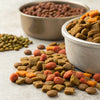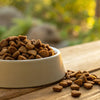How Can I Get My Dog to Eat Dry Food? Tips and Tricks for Picky Eaters
- Houndsy
Table of Contents
- Introduction
- Understanding Why Dogs Won't Eat Dry Food
- Tips to Encourage Your Dog to Eat Dry Food
- Conclusion
Introduction
Did you know that around 20% of dog owners report their pets being picky eaters? If you've ever found yourself staring at a bowl of untouched kibble, you know how frustrating and concerning it can be when your furry friend turns their nose up at dry food. As devoted pet parents, we want our dogs to enjoy their meals, not just for the sake of their health but also for the joy of mealtime bonding.
In this blog post, we will explore the common reasons behind dogs refusing to eat dry food and provide actionable strategies to encourage them to chow down. By the end of this post, we will equip you with practical tips to ensure your dog embraces their dry food, enhances their feeding experience, and even elevates your home’s dining aesthetic with our stylish Houndsy Kibble Dispenser.
We’ll delve into various factors that affect your dog’s appetite, including health concerns, food preferences, and environmental influences. We also want to remind you to reflect on your own pet-feeding routines—what works, what doesn’t, and how we can enhance the experience together.
So, let’s embark on this journey to unravel the mystery of picky eaters and discover how we can make dry food irresistible for our beloved companions.
Understanding Why Dogs Won't Eat Dry Food
Before we can effectively troubleshoot your dog’s food aversion, it’s essential to understand the reasons behind their reluctance. Here are some common factors to consider:
1. Health Issues
A sudden change in appetite can often indicate an underlying health problem. Conditions such as dental pain, nausea, or gastrointestinal issues can make eating dry food uncomfortable for your dog. If your dog shows signs of discomfort, such as pawing at their mouth, lethargy, or vomiting, it’s crucial to consult with your veterinarian.
2. Food Preferences
Just like us, dogs have their preferences. They may develop a taste for certain flavors or textures, leading them to reject dry food altogether. If your pup is used to wet food or table scraps, they might find kibble unappetizing.
3. Environmental Factors
The environment in which your dog eats can significantly impact their appetite. A noisy or busy setting may deter them from enjoying their meals. Alternatively, if their bowl is difficult to access or is too small, it can add to their reluctance to eat.
4. Picky Eating Habits
Some dogs are naturally pickier than others. If your dog is used to being spoiled with treats or table scraps, they may refuse to eat their kibble in hopes of getting something better.
5. Kibble Fatigue
Dogs can experience food fatigue, especially if they’ve been eating the same kibble for an extended period. Just as we crave variety in our meals, dogs may also seek new flavors and textures.
Tips to Encourage Your Dog to Eat Dry Food
Now that we’ve identified some common reasons your dog might not be eating dry food, let’s explore practical strategies to entice them to dig in.
1. Check Food Quality and Freshness
First and foremost, ensure that the dry food you are offering is fresh and of high quality. Expired or stale kibble can smell and taste unappealing to dogs. Always check the expiration date and store the kibble in an airtight container to maintain its freshness.
2. Enhance the Flavor
Sometimes, a little creativity can go a long way. Here are a few ideas to make dry food more enticing:
- Add Moisture: Mixing in warm water or low-sodium chicken broth can soften the kibble and enhance its aroma, making it more appealing.
- Use Toppers: Adding healthy toppers like plain yogurt, canned pumpkin, or dog-safe fruits and veggies can make a significant difference in your dog’s interest in their food.
- Switch It Up: Try rotating different flavors or brands of kibble to keep things exciting. Smaller bags can help you experiment without committing to large quantities.
3. Adjust Feeding Routine
Sometimes, changing the feeding routine can help. Here are a few tactics to consider:
- Scheduled Feeding: Instead of free-feeding, set specific mealtimes. Offer the food for 15-30 minutes, and if your dog doesn’t eat, remove it until the next meal. This method encourages them to eat when food is available.
- Quiet Eating Space: Create a calm and quiet area for mealtime. This can help your dog focus on eating without distractions.
4. Invest in the Right Feeding Equipment
A stylish and functional feeding setup can improve your dog’s dining experience. Our Houndsy Kibble Dispenser is designed with convenience and aesthetics in mind. With features like perfect portion control, a large storage capacity, and an ergonomic crank for easy dispensing, it makes mealtime enjoyable for both you and your dog. Plus, its sleek mid-century modern design complements any home decor.
5. Monitor Treats and Snacks
If your dog is snacking too much throughout the day, it may spoil their appetite for dry food. Monitor their treat intake and ensure it comprises no more than 10% of their daily caloric needs. Avoid feeding table scraps, which can also lead to picky eating habits.
6. Consult Your Veterinarian
If your dog’s lack of appetite persists despite trying the above strategies, don’t hesitate to reach out to your veterinarian. They can help rule out any medical conditions and provide tailored advice for your dog’s specific needs.
Conclusion
Getting your dog to eat dry food doesn’t have to be a daunting task. By understanding the reasons behind their reluctance and implementing these actionable strategies, we can create a more positive feeding experience. Remember, the goal is not just to fill their bellies but also to enhance their overall well-being and enjoyment during mealtime.
We encourage you to explore the Houndsy Kibble Dispenser to elevate your dog’s feeding ritual. Its innovative design and functionality can make a world of difference in creating a feeding environment that promotes healthy eating habits.
FAQ Section
Q: What should I do if my dog refuses to eat dry food? A: Start by checking the quality and freshness of the food. Enhance the flavor with moisture or toppers, and adjust their feeding routine. If the issue persists, consult your veterinarian.
Q: Can I mix wet food with dry food? A: Yes, mixing wet food with dry food can make it more palatable for picky eaters. Just ensure the overall diet remains balanced.
Q: How can I tell if my dog’s lack of appetite is due to a health issue? A: Look for additional signs such as lethargy, vomiting, or discomfort. If your dog shows any concerning symptoms, it’s best to consult with your veterinarian.
Q: How often should I feed my dog? A: Most adult dogs do well with two meals per day, while puppies may require more frequent feeding. Establish a routine that fits your dog’s age and activity level.
Q: Why is my dog eating less than usual? A: Various factors can affect appetite, including health issues, stress, or changes in routine. If the decrease is significant or prolonged, consult your vet to rule out any health concerns.
For more tips and insights on enhancing your dog’s feeding experience, don’t forget to check out our Houndsy Kibble Dispenser here. Let’s make mealtime a delightful experience for our furry friends!












